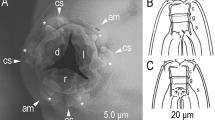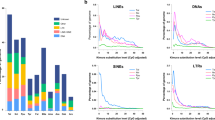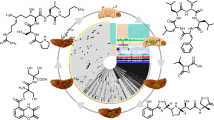Abstract
Here we present a draft genome sequence of the nematode Pristionchus pacificus, a species that is associated with beetles and is used as a model system in evolutionary biology. With 169 Mb and 23,500 predicted protein-coding genes, the P. pacificus genome is larger than those of Caenorhabditis elegans and the human parasite Brugia malayi. Compared to C. elegans, the P. pacificus genome has more genes encoding cytochrome P450 enzymes, glucosyltransferases, sulfotransferases and ABC transporters, many of which were experimentally validated. The P. pacificus genome contains genes encoding cellulase and diapausin, and cellulase activity is found in P. pacificus secretions, indicating that cellulases can be found in nematodes beyond plant parasites. The relatively higher number of detoxification and degradation enzymes in P. pacificus is consistent with its necromenic lifestyle and might represent a preadaptation for parasitism. Thus, comparative genomics analysis of three ecologically distinct nematodes offers a unique opportunity to investigate the association between genome structure and lifestyle.
This is a preview of subscription content, access via your institution
Access options
Subscribe to this journal
Receive 12 print issues and online access
$209.00 per year
only $17.42 per issue
Buy this article
- Purchase on Springer Link
- Instant access to full article PDF
Prices may be subject to local taxes which are calculated during checkout





Similar content being viewed by others
References
The C. elegans Sequencing Consortium. Genome sequence of the nematode C. elegans: A platform for investigating biology. Science 282, 2012–2018 (1998).
Kiontke, K. & Sudhaus, W. Ecology of Caenorhabditis species. in WormBook ed. (The C. elegans Research Community, WormBook, doi/10.1895/wormbook.1.37.1, 2006).
Ghedin, E. et al. Draft genome of the filarial nematode parasite Brugia malayi. Science 317, 1756–1760 (2007).
Sommer, R.J., Carta, L.K., Kim, S.-Y. & Sternberg, P.W. Morphological, genetic and molecular description of Pristionchus pacificus sp. n. Fundam. Appl. Nematol. 19, 511–521 (1996).
Hong, R.L. & Sommer, R.J. Pristionchus pacificus: a well rounded nematode. Bioessays 28, 651–659 (2006).
Zheng, M., Messerschmidt, D., Jungblut, B. & Sommer, R.J. Conservation and diversification of Wnt signaling function during the evolution of nematode vulva development. Nat. Genet. 37, 300–304 (2005).
Schlager, B., Röseler, W., Zheng, M., Gutierrez, A. & Sommer, R.J. HAIRY-like transcription factors and the evolution of the nematode vulva equivalence group. Curr. Biol. 16, 1386–1394 (2006).
Yi, B. & Sommer, R.J. The pax-3 gene is involved in vulva formation in Pristionchus pacificus and is a target of the Hox gene lin-39. Development 134, 3111–3119 (2007).
Tian, H., Schlager, B., Xiao, H. & Sommer, R.J. Wnt signaling by differentially expressed Wnt ligands induces vulva development in Pristionchus pacificus. Curr. Biol. 18, 142–146 (2008).
Herrmann, M. et al. The nematode Pristionchus pacificus is associated with the oriental beetle Exomala orientalis in Japan. Zoolog. Sci. 24, 883–889 (2007).
Srinivasan, J. et al. A bacterial artificial chromosome-based genetic linkage map of the nematode Pristionchus pacificus. Genetics 162, 129–134 (2002).
Mayer, W.E., Herrmann, M. & Sommer, R.J. Phylogeny of the nematode genus Pristionchus and implications for biodiversity, biogeography and the evolution of hermaphroditism. BMC Evol. Biol. 7, 104 (2007).
Stanke, M. & Waack, S. Gene prediction with a hidden Markov model and a new intron submodel. Bioinformatics 19 Suppl 2, ii215–ii225 (2003).
Korf, I. Gene finding in novel genomes. BMC Bioinformatics 5, 59 (2004).
Majoros, W.H., Pertea, M. & Salzberg, S.L. TigrScan and GlimmerHMM: two open source ab initio eukaryotic gene-finders. Bioinformatics 20, 2878–2879 (2004).
Alexeyenko, A., Tamas, I., Liu, G. & Sonnhammer, E.L.L. Automatic clustering of orthologs and inparalogs shared by multiple proteomes. Bioinformatics 22, e9–e15 (2006).
Finn, R.D. et al. The Pfam protein family database. Nucleic Acids Res. 36, D281–D288 (2008).
Kanehisa, M. et al. KEGG for linking genomes to life and the environment. Nucleic Acids Res. 36, D480–D484 (2008).
Stein, L.D. et al. The genome sequence of Caenorhabditis briggsae: A platform for comparative genomics. PLoS Biol. 1, 166–192 (2003).
Oesch, F. & Arand, M. Xenobiotic metabolism. in Toxicology Marquardt, H. et al. (eds.) Academic Press, San Diego, pp. 83–107 (1999).
Smant, G. et al. Endogenous cellulases in animals: isolation of β-1,4-endoglucanase genes from two species of plant-parasitic cyst nematodes. Proc. Natl. Acad. Sci. USA 95, 4906–4911 (1998).
Kikuchi, T., Jones, J.T., Aikawa, T., Kosaka, H. & Ogura, N. A family of glycosyl hydrolase family 45 cellulases from the pine wood nematode Bursaphelenchus xylophilus. FEBS Lett. 572, 201–205 (2004).
Keen, N.T. & Roberts, P.A. Plant parasitic nematodes: digesting a page from the microbe book. Proc. Natl. Acad. Sci. USA 95, 4789–4790 (1998).
Tanaka, H. et al. Insect diapause-specific peptide from the leaf beetle has consensus with a putative iridovirus peptide. Peptides 24, 1327–1333 (2003).
Dunning Hotopp, J.C. et al. Widespread lateral gene transfer from intracellular bacteria to multicellular eukaryotes. Science 317, 1753–1756 (2007).
Blaxter, M. Symbiont genes in host genomes: fragments with a future. Cell Host Microbe 2, 211–213 (2007).
Blaxter, M. et al. A molecular evolutionary framework for the phylum Nematoda. Nature 392, 71–75 (1998).
Weischer, B. & Brown, D.J.F. An Introduction to Nematodes (Pensoft, Moscow, 2000).
Poulin, R. Evolutionary Ecology of Parasites (Princeton University Press, Princeton, New Jersey, 2007).
Huang, X. et al. Application of a superword array in genome assembly. Nucleic Acids Res. 34, 201–205 (2006).
Bao, Z. & Eddy, S.R. Automated de novo identification of repeat sequence families in sequenced genomes. Genome Res. 12, 1269–1276 (2002).
Huang, X. & Madan, A. CAP3: A DNA sequence assembly program. Genome Res. 9, 868–877 (1999).
Slater, G.S.C. & Birney, E. Automated generation of heuristics for biological sequence comparison. BMC Bioinformatics 6, 31 (2005).
Allen, J.E., Majoros, W.H., Pertea, M. & Salzberg, S.L. JIGSAW, GeneZilla, and GlimmerHMM: puzzling out the features of human genes in the ENCODE regions. Genome Biol 7 Suppl 1, S9.1–S9.13 (2006).
Remm, M., Storm, C.E. & Sonnhammer, E.L. Automatic clustering of orthologs and in-paralogs from pairwise species comparisons. J. Mol. Biol. 314, 1041–1052 (2001).
Enright, A.J., Dongen, S.V. & Ouzounis, C.A. An efficient algorithm for large-scale detection of protein families. Nucleic Acids Res. 30, 1575–1584 (2002).
Sanderson, M.J. A nonparametric approach to estimating divergence times in the absence of rate constancy. Mol. Biol. Evol. 14, 1218–1231 (1997).
Acknowledgements
We thank P.W. Sternberg, J. Srinivasan and members of the Sommer lab for discussion and helpful comments on the manuscript. This work was funded by National Human Genome Research Institute grant U54HG003079 and the Max-Planck Society.
Author information
Authors and Affiliations
Contributions
C.D. carried out most of the bioinformatics analysis; the Genome Sequencing Center team at Washington University (S.W.C., A.C., K.D., L.F., R.F., J.G., P.M., M.M., S.-P.Y., R.K.W.) conducted the genome sequencing project; L.N.S. and H.T. did the experimental gene confirmation; I.D., W.R. and H.W. experimentally linked the genetic linkage map to the P. pacificus genome; and C.D., S.W.C., R.K.W. and R.J.S. designed these studies and contributed to the writing of this paper.
Corresponding authors
Supplementary information
Supplementary Text and Figures
Supplementary Figures 1–6 (PDF 708 kb)
Supplementary Table 1
Repeat family annotation. (XLS 2669 kb)
Supplementary Table 2
Gene modeller performance. (XLS 155 kb)
Rights and permissions
About this article
Cite this article
Dieterich, C., Clifton, S., Schuster, L. et al. The Pristionchus pacificus genome provides a unique perspective on nematode lifestyle and parasitism. Nat Genet 40, 1193–1198 (2008). https://doi.org/10.1038/ng.227
Received:
Accepted:
Published:
Issue Date:
DOI: https://doi.org/10.1038/ng.227
This article is cited by
-
Comparative genomics and community curation further improve gene annotations in the nematode Pristionchus pacificus
BMC Genomics (2020)
-
Screening for CRISPR/Cas9-induced mutations using a co-injection marker in the nematode Pristionchus pacificus
Development Genes and Evolution (2020)
-
Advances in the Molecular and Cellular Biology of Strongyloides spp.
Current Tropical Medicine Reports (2019)
-
Transgenesis by microparticle bombardment for live imaging of fluorescent proteins in Pristionchus pacificus germline and early embryos
Development Genes and Evolution (2018)
-
Comparative analysis of pre- and post-parasitic transcriptomes and mining pioneer effectors of Heterodera avenae
Cell & Bioscience (2017)



